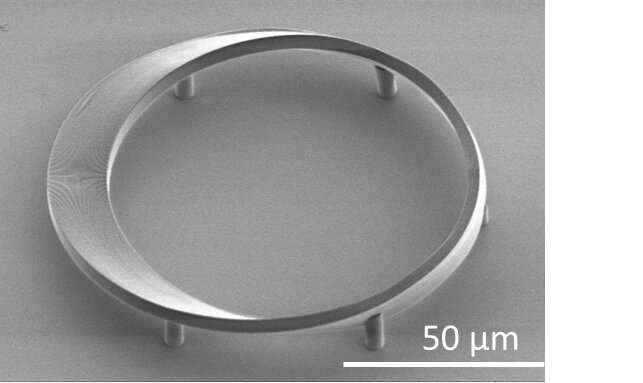November 29, 2021 feature
Möbius strip microlasers for non-Euclidean photonics applications

Photonics is a branch of technology development that specializes in the creation of devices that can generate, detect or manipulate light. Recently, researchers at Université Paris-Saclay coined a new term for a new photonics sub-field called non-Euclidean photonics.
In a paper published in Physical Review Letters, the team introduced new devices that could be used as a test bed for non-Euclidean photonics. These devices are microlasers in which the laser cavity is a curved surface. In particular, they investigated one-sided, non-orientable surfaces known as Möbius strips.
"Our project started 10 years ago with the Ph.D. thesis of Clement Lafargue," Melanie Lebental, one of the researchers who carried out the study, told Phys.org. "At the time, we had good expertise on 2D polymer-based microlasers and their use as quantum chaos platforms. We wanted to explore the third dimension, because we expected a lot of different features and a broad variety of dynamical behaviors, particularly regarding the symmetry classes of the laser modes and their polarization features."
In their past studies, Lebental and her colleagues evaluated techniques for fabricating microlasers in 3D, collaborating with researchers worldwide, including Professor I. Denisyuk at ITMO St. Petersburg and Professor J. Perry at Georgia Tech. To create the microlasers presented in their recent paper, however, they used a commercial machine developed by a company called Nanoscribe.
"We first investigated cubes, then 3D Fabry-Perot cavities and pyramids," Lebental said.
"Eventually, we realized that it was possible to fabricate surface-like cavities, which means 3D cavities, but with a small thickness (about 1 micron). We started experimenting with the Möbius strip because of its fancy topology."
Using a single sample, Lebental and her colleagues created several dozens of microlasers with different shapes and sizes. The fabrication method they employed is effective and easy to reproduce, and could thus be used to create numerous microlasers that perform well. Their device emits red light and is excited using a green pulsed laser.
"We developed several setups to characterize the laser emission, in particular a 3D goniometer to collect the emission pattern in 3D with a good spatial resolution," Lebental explained. "In our recent PRL paper, we analyzed the laser spectra with a theoretical tool called the trace formula, which provides a semiclassical approach for the identification of quantum signatures of chaos."
The skeleton of the Fourier transform of the laser's spectrum is made up of periodic classical trajectories. For curved surfaces like the Möbius strip, for example, the authors conjectured that these periodic classical trajectories are, in fact, geodesics. A geodesic is the shortest path between two points on a surface, which in Euclidean space would be a straight line.
"Our main achievement was the fabrication of the Möbius strip microlasers," Lebental said. "As far as I know, this is the first time that such a cavity was fabricated. Moreover, the quality of our cavity is very high and so is its reproducibility. In brief, we demonstrated that the laser modes are located along periodic geodesics."
The 3D fabrication of microlasers could be a crucial step in the development of new photonic technologies. To describe this emerging research field, Lebental and her colleagues coined the term "non-Euclidian photonics." They believe that there could soon be new theoretical and experimental results in this area; for instance, uncovering the polarization features and the diversity of modes of the new microlasers.
"We hope that other people will want to investigate this new field of research," Lebental added. "We are now planning to conduct further studies in the field of non-Euclidean photonics; for instance, investigating cavity shapes that are simpler than the Möbius strip, where the periodic geodesics can be calculated more easily. The theory of usual photonics must be revisited for non-Euclidean photonics and I think this new line of work is very exciting, as there is still much to uncover."
More information: Yalei Song et al, Möbius Strip Microlasers: A Testbed for Non-Euclidean Photonics, Physical Review Letters (2021). DOI: 10.1103/PhysRevLett.127.203901
E. Bogomolny et al, Trace formula for dielectric cavities. II. Regular, pseudointegrable, and chaotic examples, Physical Review E (2011). DOI: 10.1103/PhysRevE.83.036208
Vincent W. Chen et al, Three-dimensional organic microlasers with low lasing thresholds fabricated by multiphoton and UV lithography, Optics Express (2014). DOI: 10.1364/oe.22.012316
N. Sobeshchuk et al, Out-of-plane modes in three-dimensional Fabry-Perot microlasers, Applied Physics Letters (2018). DOI: 10.1063/1.5033496
M. A. Guidry et al, Three-dimensional micro-billiard lasers: The square pyramid, EPL (Europhysics Letters) (2019). DOI: 10.1209/0295-5075/126/64004
Clément Lafargue et al, Three-dimensional emission from organic Fabry-Perot microlasers, Applied Physics Letters (2013). DOI: 10.1063/1.4812667
Journal information: Physical Review Letters , Physical Review E , Optics Express , Applied Physics Letters
© 2021 Science X Network




















